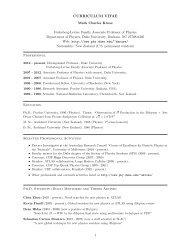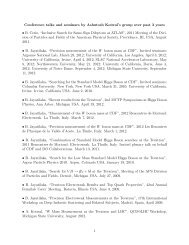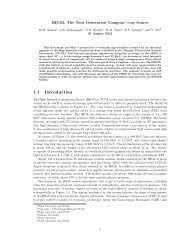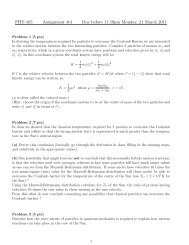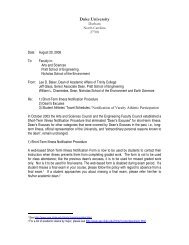Trichloroethylene - Duke Physics
Trichloroethylene - Duke Physics
Trichloroethylene - Duke Physics
You also want an ePaper? Increase the reach of your titles
YUMPU automatically turns print PDFs into web optimized ePapers that Google loves.
Check for and remove any contact lenses. Immediately flush eyes with running water for at least 15 minutes, keeping eyelids<br />
open. Cold water may be used. Do not use an eye ointment. Seek medical attention.<br />
Skin Contact:<br />
After contact with skin, wash immediately with plenty of water. Gently and thoroughly wash the contaminated skin with running<br />
water and non-abrasive soap. Be particularly careful to clean folds, crevices, creases and groin. Cover the irritated skin with an<br />
emollient. If irritation persists, seek medical attention. Wash contaminated clothing before reusing.<br />
Serious Skin Contact:<br />
Wash with a disinfectant soap and cover the contaminated skin with an anti-bacterial cream. Seek medical attention.<br />
Inhalation: Allow the victim to rest in a well ventilated area. Seek immediate medical attention.<br />
Serious Inhalation:<br />
Evacuate the victim to a safe area as soon as possible. Loosen tight clothing such as a collar, tie, belt or waistband. If<br />
breathing is difficult, administer oxygen. If the victim is not breathing, perform mouth-to-mouth resuscitation. Seek medical<br />
attention.<br />
Ingestion:<br />
Do not induce vomiting. Loosen tight clothing such as a collar, tie, belt or waistband. If the victim is not breathing, perform<br />
mouth-to-mouth resuscitation. Seek immediate medical attention.<br />
Serious Ingestion: Not available.<br />
Section 5: Fire and Explosion Data<br />
Flammability of the Product: May be combustible at high temperature.<br />
Auto-Ignition Temperature: 420°C (788°F)<br />
Flash Points: Not available.<br />
Flammable Limits: LOWER: 8% UPPER: 10.5%<br />
Products of Combustion: These products are carbon oxides (CO, CO2), halogenated compounds.<br />
Fire Hazards in Presence of Various Substances: Not available.<br />
Explosion Hazards in Presence of Various Substances:<br />
Risks of explosion of the product in presence of mechanical impact: Not available. Risks of explosion of the product in<br />
presence of static discharge: Not available.<br />
Fire Fighting Media and Instructions:<br />
SMALL FIRE: Use DRY chemical powder. LARGE FIRE: Use water spray, fog or foam. Do not use water jet.<br />
Special Remarks on Fire Hazards: Not available.<br />
Special Remarks on Explosion Hazards: Not available.<br />
Section 6: Accidental Release Measures<br />
Small Spill: Absorb with an inert material and put the spilled material in an appropriate waste disposal.<br />
Large Spill:<br />
Absorb with an inert material and put the spilled material in an appropriate waste disposal. Be careful that the product is not<br />
present at a concentration level above TLV. Check TLV on the MSDS and with local authorities.<br />
Section 7: Handling and Storage<br />
Precautions:<br />
Keep locked up Keep away from heat. Keep away from sources of ignition. Empty containers pose a fire risk, evaporate the<br />
residue under a fume hood. Ground all equipment containing material. Do not ingest. Do not breathe gas/fumes/ vapour/<br />
p. 2



